West Midlands
Explore hidden histories, historic photos, and things you never knew about West Midlands from the collections and archives of Historic England.
Discover your local listed buildings and places
Introducing some of West Midlands' most historic sites, included in the National Heritage List for England. Some of these captions have been summarised by AI. Click through for the official List entry. Skip this section and go to place by numbers
Coventry Central Baths (original part including sunbathin…
Coventry
Swimming Baths with attached sunbathing terraces.
Elmdon Terminal Building, Birmingham Airport
Bickenhill and Marston Green
The Elmdon Building, Birmingham Airport, of 1939 by Norman and Dawbarn.
Curzon Street: The former Principal Building of the Birmi…
Birmingham
The Principal Building of Birmingham Station, the northern terminus of the London and Birmingham Railway, designed in a Greek Revival style by Philip Hardwick and opened in 1838.
21, Yateley Road B15
Birmingham
Designed by H T Buckland in 1899, 21 Yateley Road is an Arts and Crafts style house with an original interior, stained glass, and notable fireplaces.
Coventry Synagogue and Rabbi's House
Coventry
A synagogue and rabbi's house of 1870, designed by Thomas Naden of Birmingham, of red brick with blue brick and painted stone dressings and a plain tile roof in a simplified Romanesque style.
16, Norfolk Road B15
Birmingham
Offices, formerly a house. Designed by Yeoville Thomason and built in 1854-7 for James Heacock Bodington.
Sutton Park
Sutton Coldfield
Sutton Park, originally a 12th-century deer park, became public land in 1528 under Bishop Vesey, developing into a recreational and historical site with woodland and water features.
Technical Institute and Public Library, Brierley Hill
Brierley Hill
A Carnegie library and technical institute of 1903-4, designed by the borough surveyor to Brierley Hill, Lewis Harper and built by CA Horton.
80 Broad Street and boundary walls to front
Birmingham
An early-C19 former residence, later a hospital for women and children, and most recently a bar, restaurant, and nightclub, with C19, C20 and C21 extensions and alterations.
The Rotunda, including the shops in the podium below the …
Birmingham
Former office building with shops on the first and ground floors. Begun 1960, completed to revised designs 1964-5 and designed by the architect James Roberts (born 1922).
Lawley Street Railway Viaduct
Birmingham
A viaduct of 1838, designed by Joseph Locke, to take the Grand Junction railway line into the Curzon Street Terminus Station.
Great Barr Hall
Sandwell
An C18 landscape park associated with a country house; associated with Humphry Repton and John Nash and George Gilbert Scott, and possibly with William Shenstone.
Former White Lion Public House
Birmingham
A public house of 1896 by James and Lister Lea with attached late-C18 building to the north.
Coventry City Library building (former Locarno Dancehall)
Coventry
A former dance hall, now the Coventry central library.
Roman forts at Metchley
Birmingham
Metchley Roman fort, of national significance, offers insight into Roman military strategies and occupation patterns, with preserved artifacts and diverse phases of internal development over...
Coventry Retail Market
Coventry
A market hall built in 1957 to designs by Douglas Beaton, Ralph Iredale and Ian Crawford of Coventry City Architect's Department.
Walsall Arboretum
Walsall
Walsall Arboretum, established in 1874 as a public park on former Reynolds Hall site, features extensive gardens and lakes influenced by Victorian design.
The Register Office, formerly the Cheylesmore Manor gateh…
Coventry
Gatehouse and cross-wings to a C14 manor house, restored in the mid-C20 by FWB Charles.
Uffculme School
Birmingham
The principal buildings of the former open-air school at Uffculme, built in 1911 to a design by Barry Peacock - namely the main block with attached classroom, and the three pavilion...
Great Barr Hall and Chapel
Pheasey
A country house which was converted to use as a hospital in the early C20.
The Black Horse public house
Birmingham
A public house, designed by Francis Goldsbrough (of Bateman and Bateman) for the brewers John Davenport & Sons and built in 1929-30 in a late-medieval and Tudor style, designed to represent...
Diddington Hall
Hampton in Arden
Diddington Hall, a late 16th-century building, features red brick and sandstone, gabled roofs, stone fireplaces, and a 17th-century staircase with intricate details.
Motte and bailey castle with later moated site at Stonebr…
Kingshurst
Motte and bailey castles were strategic Norman fortifications and aristocratic residences crucial to Norman Britain's history.
Whitefriars Museum
Coventry
Originally founded as a Carmelite Priory circa 1342, the building served as a private residence, workhouse, and is now a museum, restored after WWII bombing.
Former Nurses' Home and Outpatients' Clinic at Coventry a…
Coventry
A former outpatients' clinic (1909) and nurses' home (1906) for Coventry and Warwickshire Hospital built to a design by Alfred Hessell Tiltman (1854-1910) and Herbert William Chattaway...
Roman Catholic Church of Our Lady of the Rosary and St Th…
Birmingham
A Roman Catholic parish church. 1932-4. Repaired and restored in the 1940s. Designed by George Drysdale in the Lombard style, an amalgamation of Early-Christian and Romanesque styles.
Broadgate House
Coventry
Office buildingDeveloped from a masterplan of 1941, built 1949-53 by Coventry City Architect's Department, Chief Architect Donald EE Gibson, assistant in charge Frank Moate, in succession to...
Church of St John the Baptist
Coventry
Newly constructed in 1842-43 by George Gilbert Scott and William Bonython Moffat.
Friends' Institute Building, 220 Moseley Road
Birmingham
A former Quaker meeting hall and institute building, built under the patronage of Richard Cadbury and designed by Ewan Harper. The building opened in 1897.
Birmingham Botanical Gardens
Birmingham
Established in the 1830s, the Birmingham Botanical Gardens highlight J.C.
Birmingham Gun Barrel Proof House
Birmingham
A gun barrel proof (testing) house commissioned by the Guardians of the Birmingham Gun Barrel Proof House from John Horton and opened in 1813.
Kent's Moat
Birmingham
Kent's Moat, a medieval site in England, served as an aristocratic residence, with its moat symbolizing status. It preserves historic artefacts and building remains.
Whitefriars Gate, 36-37 Much Park Street
Coventry
Postern gatehouse to the Carmelite friary, late C14 or C15, later converted to form two dwellings.
Former Leofric Hotel
Coventry
A student hall of residence, built as an hotel in 1953-1955 to the designs of WS Hattrell and Partners.
Walsall Memorial Garden
Walsall
Walsall Memorial Garden, designed by Geoffrey Jellicoe, opened in 1952 as a tribute to war casualties, showcasing his design evolution.
Cathedral of St Michael
Coventry
Cathedral of St Michael, designed by Sir Basil Spence (1951-62), is a significant architectural work, integrating modern design with historic elements from the bomb-damaged medieval church.
Explore more
Search for more listed placesWest Midlands through time
This timeline shows the first period of use for buildings and places on the National Heritage List for England, just one of the details recorded for every list entry. Click around to see how West Midlands changes over time. Skip this section and go to aerial photos
Prehistoric Before AD 43
Prehistory covers a million years of human occupation before the Roman invasion, from hunter-gatherers of several human species, including Neanderthals, to more recent herders and farmers. It was a time of developing technologies and belief systems, involving contact with and migration from Europe, all reflected in the variety of artefact and monument types characteristic of particular prehistoric periods.
We don't have an image for any of these list entries yet
Roman AD 43 to AD 410
Britain was invaded by four legions of the Roman army in AD 43, who relatively rapidly conquered England from landing points in Kent. Parts of Wales and Scotland soon followed.
Roman culture brought urbanism, monumental buildings, wide-ranging religious beliefs, writing, and strong social hierarchy. The Roman administrative system was withdrawn in AD 410.
Early medieval AD 410 to AD 1066
This period, often associated in England with Anglo-Saxons and Vikings, saw a reduction in urban living from the Roman period and increased migration from northern Europe.
Traces of this period can be found in cemeteries, particularly in artefacts and in some of the very early churches, as this period also saw the growth of Christianity in Britain.
Medieval AD 1066 to AD 1540
This period, sometimes known as the Middle Ages, began with the Norman invasion in AD 1066. It saw a significant rise in military and defensive buildings such as castles and earthworks, as well as religious houses dominating a largely agricultural landscape.
The monarchy and Church dominated the period, which also saw the break with the Roman Catholic Church and the English reformation.
Post medieval AD 1540 to AD 1901
The Post-Medieval period brought seismic changes to life in England, with religious reformation leading to the democratization of worship and the destruction of hundreds of religious houses.
In parallel, there was a huge expansion of scientific study and enlightenment that permanently altered the nation's social structure and landscape. Industrialization and mass production lead to wider global trade, emigration, and immigration.
20th century AD 1901 to AD 2000
The 20th century saw an incredible expansion of England's transport networks, with suburban growth shadowing rapid infrastructural expansion. The establishment of state schools, hospitals, and modern technical colleges, with new architectural styles, radically changed the appearance of towns and cities.
Two catastrophic world wars and the 1918 pandemic also brought unprecedented change, altering England's built environment and social structures forever.
Prehistoric Before AD 43
Prehistory covers a million years of human occupation before the Roman invasion, from hunter-gatherers of several human species, including Neanderthals, to more recent herders and farmers. It was a time of developing technologies and belief systems, involving contact with and migration from Europe, all reflected in the variety of artefact and monument types characteristic of particular prehistoric periods.
We don't have an image for any of these list entries yet
Roman AD 43 to AD 410
Britain was invaded by four legions of the Roman army in AD 43, who relatively rapidly conquered England from landing points in Kent. Parts of Wales and Scotland soon followed.
Roman culture brought urbanism, monumental buildings, wide-ranging religious beliefs, writing, and strong social hierarchy. The Roman administrative system was withdrawn in AD 410.
Early medieval AD 410 to AD 1066
This period, often associated in England with Anglo-Saxons and Vikings, saw a reduction in urban living from the Roman period and increased migration from northern Europe.
Traces of this period can be found in cemeteries, particularly in artefacts and in some of the very early churches, as this period also saw the growth of Christianity in Britain.
Medieval AD 1066 to AD 1540
This period, sometimes known as the Middle Ages, began with the Norman invasion in AD 1066. It saw a significant rise in military and defensive buildings such as castles and earthworks, as well as religious houses dominating a largely agricultural landscape.
The monarchy and Church dominated the period, which also saw the break with the Roman Catholic Church and the English reformation.
Post medieval AD 1540 to AD 1901
The Post-Medieval period brought seismic changes to life in England, with religious reformation leading to the democratization of worship and the destruction of hundreds of religious houses.
In parallel, there was a huge expansion of scientific study and enlightenment that permanently altered the nation's social structure and landscape. Industrialization and mass production lead to wider global trade, emigration, and immigration.
20th century AD 1901 to AD 2000
The 20th century saw an incredible expansion of England's transport networks, with suburban growth shadowing rapid infrastructural expansion. The establishment of state schools, hospitals, and modern technical colleges, with new architectural styles, radically changed the appearance of towns and cities.
Two catastrophic world wars and the 1918 pandemic also brought unprecedented change, altering England's built environment and social structures forever.
Aerial photos of West Midlands
Aerial photography helps reveal secrets of England's changing landscapes that are impossible to see from the ground. Skip this section and go to archive images

Shirley
The Carco Protective Paper Packings Mill and Cranmore Mills, Cranmore Boulevard and environs, Shirley, 1952
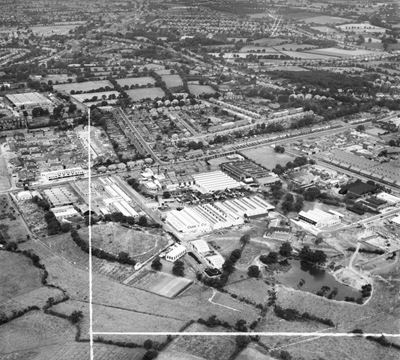
Shirley
The Carco Protective Paper Packings Mill and Cranmore Mills, Cranmore Boulevard and environs, Shirley, 1952

Edgbaston
The University of Birmingham, Edgbaston, 1928
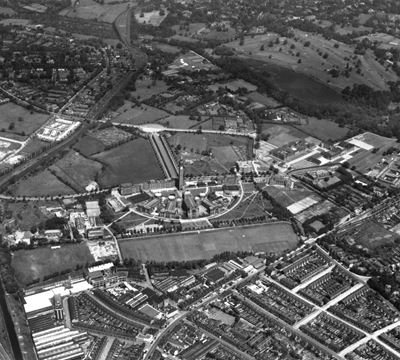
Edgbaston
The University of Birmingham and environs, Edgbaston, 1948
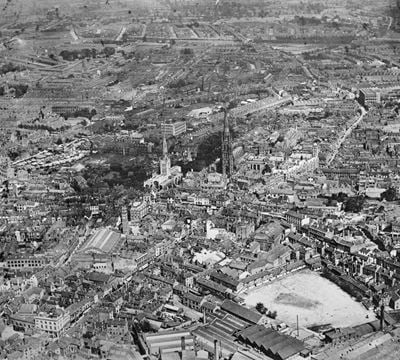
Coventry
The city centre, Coventry, 1920

Coventry
Ring road and city centre, Coventry, 1970
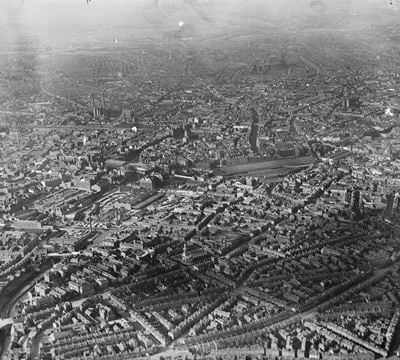
Birmingham
Birmingham New Street Station and town centre, Birmingham, 1920

Birmingham
Victoria Square showing the construction of the Central Library, Birmingham, 1969

Dudley
Dudley Castle, Dudley, 1928
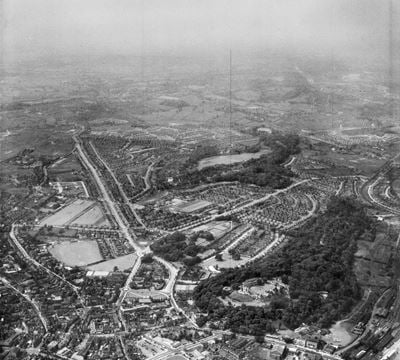
Dudley
Dudley Castle and Priory Estate, Dudley, 1953
West Midlands in the Historic England Archive
The Historic England Archive cares for over 15 million images, dating from the 1850s to the present day. Discover stunning images of West Midlands' past. Skip this section and go to stories about heritage
Charles George Harper Collection
Wolverhampton, City Of Wolverhampton
Date created: 1800 - 1900
Pencil drawing showing the Anglo Saxon cross shaft in the churchyard of St Peter's Collegiate Church, by an unknown artist
Eric de Mare
Solihull
Date created: 1945 - 1980
General view of Solihull Electricity Transformer Station.
John Gay Collection: Modern Architects
Edgbaston, Birmingham, Birmingham
Date created: 1973 - 1979
Part of the exterior of the Employment Rehabilitation Centre in Edgbaston showing the visitors entrance on the north elevation
John Gay Collection: Miscellaneous
Coventry
Date created: 1955 - 1956
The foundation stone for Coventry Cathedral inscribed 'To the glory of GOD this Foundation Stone was laid by Queen Elizabeth the Second on the 23rd...
John Gay Collection: Counties
Coventry
Date created: 1954
Detail of a large vent at the Armstrong Siddeley car and aircraft engine works
John Laing Collection
Edgbaston Campus, Birmingham, Birmingham
Date created: 28 Sep 1966
View of the Radiation and Physics Block at Birmingham University
London, Midland and Scottish Railway Company
Bournville, Birmingham
Date created: 01 May 1928
A view of a loading bay at Cadbury's Chocolate Factory, with boxes of confectionary being loaded into delivery vans
Nigel Temple Collection of Postcards of Parks and Gardens
Moseley, Birmingham
Date created: 1910 - 1940
GENERAL VIEW ACROSS LAKE TO HOUSE
John Gay Collection: Modern Architects
Edgbaston, Birmingham, Birmingham
Date created: 1973 - 1979
A view looking along the east elevation of the Employment Rehabilitation Centre in Edgbaston
John Laing Collection
Edgbaston Campus, Birmingham, Birmingham
Date created: 28 Sep 1966
View of the Radiation and Physics Block at Birmingham University
Nigel Temple Collection of Postcards of Parks and Gardens
Moseley, Birmingham
Date created: 1900 - 1930
GENERAL VIEW OF MOSELEY PARK POOL
Stories about heritage in your local area
Historic England publishes news, blogs, research, videos, and podcasts celebrating England's rich heritage. Discover the stories we have about West Midlands. Skip this section and go to education
Birmingham School with a Grand Central Hall Awarded Rare Grade II* Listed Status
Mentions The Old Crown Public House, Balsall Heath Library and Balsall Heath Public Baths, Council House, City Museum and Art Gallery and Council House extension
King Edward VI Girls Grammar School in Handsworth, Birmingham, has been granted Grade II* listed status by DCMS on the advice of Historic England.
A Brief Introduction to the History of the Railway in England
Discover when the first steam train was invented in England, and when the world's first public railway opened in Stockton and Darlington in 1825.
A History of Bradford in 10 Places
Mentions Town Hall
Discover the history of Bradford's buildings including Cartwright Hall, Lister Mills, UNESCO site Saltaire, Bradford Cathedral and Brontë Parsonage...
English High Street Architecture Through the Ages
Mentions Ruined Cathedral Church of St Michael, Broadgate House
Explore how the architecture of the English high street has evolved over the centuries.
The Life, Love and Legacy of Feminist Pioneer Rose Sidgwick
Mentions Great Hall and Quadrant Range
Unpick the legacy of the historian who made pioneering contributions to history and international feminism.
The Buildings of Architect Ernő Goldfinger
Mentions Goldfinger House
Discover the modernist buildings of Hungarian-born architect Ernő Goldfinger, including Trellick Tower, Balfron Tower and 2 Willow Road.
5 Art Nouveau Buildings in England
Mentions Horse and Jockey
Explore some of England’s beautiful Art Nouveau buildings featuring flowing lines and floral designs.
6 Historic Places That Inspired Tolkien’s Lord of the Rings
Mentions Sarehole Mill, The Monument (Observatory)
Catch a glimpse of Middle-Earth at these listed historical sites in England.
The History of Ukrainians in England
Mentions Church of St Mark and boundary walls to Stoney Stanton Lane and Bird Street
Ukrainians have influenced several sites across England. Here is a small selection.
The Art of Bell Ringing: The Bells of Brierley Hill
Mentions Church of St Michael
Bell ringing has returned to Brierley Hill in the West Midlands after locals purchased special equipment that allows them to practice in silence.
A Brief History of Prefabs
Mentions 427, Wake Green Road
Over 200,000 homes in Britain were destroyed by bombs during the Second World War.
8 of England’s Most Beautiful Cathedrals to Visit
Mentions Cathedral of St Michael
From Norman to Modernist, there are many different architectural styles on show in England’s cathedrals.
These Places in England are Accidentally Wes Anderson
Mentions Balsall Heath Library and Balsall Heath Public Baths, The Barber Institute at Birmingham University
Will one of these places be the setting for the next West Anderson next film?
Wednesbury | Flying | story by Maria Whatton
In 'Flying', Maria wanted to capture Black Country dialect. Growing up in Wednesbury, her character Lily May can only dream of having the confidence her friends all seem to have. On a special day when spirits stir, it’s Lily May who discovers a new side to Wednesbury, and herself. You can download the ebook of all the stories at https://historicengland.org.uk/highstreettales Made in conjunction with New Writing North and Writing West Midlands, and the series was produced by Sonderbug Productions with thanks to Darren Hayman for use of his song Pram Town. High Street Tales is part of Historic England’s high street cultural programme; four years of nationwide cultural activity helping to make high streets more attractive, engaging and vibrant places for people to live, work and spend time. The programme is run by Historic England, in partnership with Heritage Lottery Fund and Arts Council England. Follow us on social @HistoricEngland, using the hashtag #HighStreetTales.
Mentions West Midlands
Brierley Hill resident Tim Sunter took up bellringing in 2014 after seeing a tweet saying that the bells of St Michael’s didn’t ring anymore.
The Bells of Brierley Hill
Brierley Hill resident Tim Sunter took up bellringing in 2014 after seeing a tweet saying that the bells of St Michael’s didn’t ring anymore.
Birmingham School with a Grand Central Hall Awarded Rare Grade II* Listed Status
Mentions The Old Crown Public House, Balsall Heath Library and Balsall Heath Public Baths, Council House, City Museum and Art Gallery and Council House extension
King Edward VI Girls Grammar School in Handsworth, Birmingham, has been granted Grade II* listed status by DCMS on the advice of Historic England.
Researching High Street Heritage Action Zones
Mentions West Midlands
Research by Historic England is adding value to the regeneration of historic high streets.
17 Remarkable Historic Places Listed in 2024
Mentions The Mitre Inn
Celebrating 17 historic gems that were examined, protected and added to the National Heritage List for England in 2024.
Introduction to Issue 26
Mentions West Midlands
This issue explores aspects of industrial heritage, Palaeolithic landscapes, and the relationship between intertidal heritage and biodiversity.
Funding for Young People to Explore and Celebrate Their Local History
Mentions West Midlands
Historic England has announced new funding for 21 creative youth-led place-marking projects across England.
Historic England Reveals its Heritage at Risk Register 2024
Mentions West Midlands
Historic England has today revealed its Heritage at Risk Register 2024. This is a snapshot of the health of England’s historic buildings and places.
New Funding to Celebrate Rural and Coastal Working-Class Heritage
Mentions West Midlands
Historic England is funding new projects to explore untold stories and celebrate the people and places at the heart of our history.
Birmingham’s Craven Arms Pub Listed at Grade II
Mentions The Craven Arms, West Midlands
A pub in Birmingham City Centre featuring a striking two-tone tiled exterior, has been granted listed status.
500 Years of Oasts and Hop Kilns in England
Mentions West Midlands
An overview of the research behind a recent Historic England book, which tells the story of hop processing.
Southend-on-Sea Civic Fountain Listed
Mentions Mural at the Three Tuns Pub
The Civic Fountain in Southend-on-Sea, Essex, has been listed at Grade II by DCMS on the advice of Historic England.
Birmingham’s Cavern Club ‘The Cradle of Heavy Metal’ Secures Grade II Listing
Mentions The Crown Hotel, Station Street, Birmingham
Heritage music venue recognised for role played in the development of heavy metal music and the career of famous Birmingham based band, Black Sabbath.
Historic England Supports University of Sussex Plans for Listed Library
Mentions Cathedral of St Michael
Historic England supports plans to improve access to the University of Sussex’s Grade II* listed Library, designed by architect Sir Basil Spence.
West Midlands' social history through photos
Over 10,000 images from the Historic England Archive have been specially selected and re-captioned for teachers, students, and anyone who wants to learn more about their local area. Skip this section and go to grant-aided places
Wulfruna Memorial, Wolverhampton, West Midlands
Period: Victorian (1837 - 1901)
Wulfruna Memorial, dated 1901. The inscription reads IN/ REMEMBRANCE OF/ THE LADY WULFRUNA/ AD 994/ STAVELY HILL P.G.,K.G./ AD 1901.
Wulfruna Memorial, Wolverhampton, West Midlands
Tags
Workers housing, Willow Street, Bournville, West Midlands
Period: Victorian (1837 - 1901)
From 1895 Bournville was developed as a model village associated with the chocolate factory of the philanthropist George Cadbury.
Workers housing, Willow Street, Bournville, West Midlands
Worcester Bank, Birmingham, West Midlands
Period: Victorian (1837 - 1901)
This is a banking hall at the Worcester Bank on Colmore Row, Birmingham.
Worcester Bank, Birmingham, West Midlands
Tags
Woodlands School, Coventry, West Midlands
Period: 1950s (1950 - 1959)
The Main Block at Woodlands School was built in 1952-57 by the City Architects Department with the Ministry of Education Development Group.
Woodlands School, Coventry, West Midlands
Wolverhampton Synagogue, Fryer Street, Wolverhampton, West Midlands
Period: Edwardian (1902 - 1913)
The front elevation of the synagogue, built in 1903-4 by F J Beck. It closed in 1999 and is being converted to a new use.
Wolverhampton Synagogue, Fryer Street, Wolverhampton, West Midlands
Wolverhampton Grammar School, Wolverhampton, West Midlands
Period: Victorian (1837 - 1901)
Wolverhampton Grammar School dates back to 1515 when the school was founded by Stephen Jenys of the Merchant Taylors' Guild in the town centre.
Wolverhampton Grammar School, Wolverhampton, West Midlands
Tags
Winding engine house, Halesowen, West Midlands
Period: Victorian (1837 - 1901)
Winding engine house at the former New Hawne Colliery, built in 1865.
Winding engine house, Halesowen, West Midlands
Whitley Abbey School, Whitley, Coventry, West Midlands
Period: 1950s (1950 - 1959)
Whitley Abbey School was built in 1955-7. Its landscaped grounds include a lake.
Whitley Abbey School, Whitley, Coventry, West Midlands
Visit grant-aided places near you
These places and buildings have been helped by Historic England's financial grants. Find local heritage in your neighbourhood that you never knew existed! Please note that opening times may vary. Skip this section and go to related locations
Highbury Gardens, 4 Yew Tree Road, Moseley, Birmingham
The building is a Venetian Gothic, Ruskin-inspired Victorian mansion house set in a designed landscape.
Highbury Hall, 4 Yew Tree Road, Moseley, Birmingham
Highbury Hall, a Grade II* Victorian mansion built in 1876 for Joseph Chamberlain, is set within its own grounds.
Newman Brothers Coffin Fitting Works, 13-15 Fleet Street, Birmingham
This purpose-built factory, dating from 1894, was used for manufacturing fittings, funerary shrouds, and coffin linings.
The Roundhouse, 101 Vincent Street, Birmingham
The horseshoe-shaped Roundhouse Birmingham features gatehouses, an inner courtyard, and a visitor centre with catering facilities open to the public.
Winson Green Seventh Day Adventist Church, 60 Beeton Road, Winson Green, Birmingham
Built in 1904, the historic parish church in Winson Green features a working pipe organ designed by William Bidlake, which is still used in worship...
Discover more
Ready for more local stories? Take a look at these other places nearby


